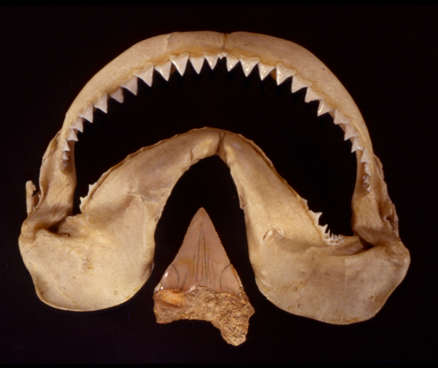
 |
 |
 |
 |
 |
 |
 |
 |
 |
| HOME |
FOSSILS
PAGE |
LAST
DRAWER |
LAST
IMAGE |
NEXT
IMAGE |
NEXT
DRAWER |
MORE
TEXT |
IMAGE
INFO |
LINKS |
...... set: fossils // series:
carcharodon // picture:
MEGALODON
set: fossils // series:
carcharodon // picture:
MEGALODON
Sharks
represent one of the main classes of fish to have conquered the seas, and
so about 70% of the Earth's surface area. Their cartilaginous skeletons decompose
after death so are rarely found as fossils, but their teeth have high preservation
potential. The teeth of the largest shark are commonly known under the name
of Carcharodon megalodon (from the Greek for "saw-tooth" and "big-tooth",
after the serrated edge of the teeth and their great size). A small example
is illustrated here (?? mm long), from the Miocene of Malta (and so about
15 million years old) together with the jaws of its closest present-day relative
- the Great White Shark, supposedly notorious as the "Man-eater".
Vertebrate palaeontology forms part of our core teaching in palaeontology
in both first and second years of undergraduate study, and optional course
units thereafter. There is also research interest in the Department in the
Miocene of Malta, although our recent research in vertebrate palaeontology
has focused more on fossil birds (of Gibraltar) and mammals (of England) than
sharks.
